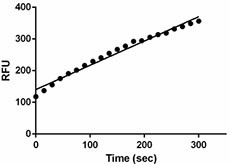- Regulatory Status
- RUO
- Other Names
- CTSB, CPSB, APP secretase, APPS, Cathepsin B1, CB

-

Mouse CTSB enzyme activity was measured using a fluorogenic peptide substrate Z-Leu-Arg-AMC.
| Cat # | Size | Price | Quantity Check Availability | ||
|---|---|---|---|---|---|
| 763002 | 10 µg | $223.00 | |||
| 763004 | 25 µg | $440.00 | |||
| 763006 | 100 µg | $1167.00 | |||
Select size of product is eligible for a 40% discount! Promotion valid until December 31, 2024. Exclusions apply. To view full promotion terms and conditions or to contact your local BioLegend representative to receive a quote, visit our webpage.
Cathepsin B, also known as CTSB, is a lysosomal cysteine protease. While most cathepsins are exclusively endopeptidases, CTSB exhibits both carboxypeptidase and endopeptidase activities. The optimal pH for CTSB activity is between four and six. Cystatin C has been identified as an endogenous CTSB inhibitor. High CTSB protein levels and activities have been found in many tumors including breast, cervix, colon, stomach, glioma, lung, and thyroid tumors. CTSB can be secreted by tumor cells and is associated with the cell membrane of these cells. Membrane associated CTSB promotes extracellular matrix (ECM) degradation, which contributes to cancer motility and invasion. Many ECM proteins, including laminin, fibronectin, and collagen IV, are substrates of CTSB. CTSB can also activate pro-uPA/PLAU. Activated uPA promotes ECM digestion through serine protease plasminogen. It has been shown that the inhibition of CTSB can limit bone metastasis in breast cancer, making it an important anti-cancer drug target. CTSB has been proposed as a new drug target for Alzheimer's disease because of its involvement in the production of neurotoxic β-amyloid (Aβ) peptides. The inhibition of CTSB can reduce the brain Aβ peptides and improve memory which was determined from a mouse model with Alzheimer's disease. CTSB also plays significant roles in immune responses including both T and B cell apoptosis and Th1/Th2 polarization. CTSB is implicated in other pathological conditions including cardiovascular disease, multiple sclerosis, and arthritis. The roles of CTSB in autophagy, adipogenesis, and cholesterol absorption in the intestine have also been studied.
Product Details
- Source
- Mouse Cathepsin B, amino acids (His18-Phe339) (Accession# P10605), with C-terminal 10x His tag, was expressed in CHO cells.
- Molecular Mass
- The 332 amino acid recombinant protein has a predicted molecular mass of approximately 36.7 kD. The protein migrates at approximately 45 kD in DTT-reducing conditions and at approximately 40 kD in non-reducing conditions by SDS-PAGE. The predicted N-terminal amino acid is His.
- Purity
- >95%, as determined by Coomassie stained SDS-PAGE under reducing conditions.
- Formulation
- 0.22 µm filtered protein solution is in 25 mM Tris, 150 mM NaCl, and pH 7.5.
- Endotoxin Level
- Less than 0.01 ng per µg cytokine, as determined by the LAL method.
- Concentration
- 10 and 25 µg sizes are bottled at 200 µg/mL. 100 µg size and larger sizes are lot-specific and bottled at the concentration indicated on the vial. To obtain lot-specific concentration and expiration, please enter the lot number in our Certificate of Analysis online tool.
- Storage & Handling
- Unopened vial can be stored at -20°C for one month, or at -70°C for six months. For maximum results, quick spin vial prior to opening. Avoid repeated freeze/thaw cycles.
- Activity
- The activity of Cathepsin B is determined by its ability to cleave the fluorogenic peptide substrate, Z-Leu-Arg-AMC (Z=Benzyloxycarbonyl, and AMC=7-amino-4-methylcoumarin) after activation. The specific activity is > 3600 pmol/min/µg.
- Application
-
Bioassay
- Application Notes
-
Cathepsin B Activity Protocol:
1. Dilute the recombinant mouse Cathepsin B to 10 μg/ml in activation buffer (25 mM MES, 1 mM DTT, pH 5.0) and incubate the protein at 25°C for 3 min. Over activation may result in proteolysis and low activity.
2. Dilute the recombinant mouse Cathepsin B to 0.05 μg/ml in assay buffer (25 mM MES, pH 5.0).
3. Dilute the fluorogenic peptide substrate (Z-LR-AMC) to 40 μM using assay buffer.
4. Perform the assay in a 96-well, black, flat-bottomed plate. Add 50 μl of the diluted, activated Cathepsin B (0.0025 µg/well) to a black well and start the reaction by adding 50 μl of 40 μM substrate. The assay is read on a fluorometer at excitation and emission wavelengths of 380 nm and 460 nm for five minutes (top read).
This protein is in the latent form and needs to be activated for bioassay.
BioLegend carrier-free recombinant proteins provided in liquid format are shipped on blue-ice. Our comparison testing data indicates that when handled and stored as recommended, the liquid format has equal or better stability and shelf-life compared to commercially available lyophilized proteins after reconstitution. Our liquid proteins are verified in-house to maintain activity after shipping on blue ice and are backed by our 100% satisfaction guarantee. If you have any concerns, contact us at tech@biolegend.com.
Antigen Details
- Structure
- Cysteine protease.
- Distribution
-
CTSB is ubiquitously expressed and is normally localized to lysosomes. However, it can also be secreted by many cells including tumor cells, macrophages, fibroblasts, osteoclasts, T lymphocytes, and neutrophils.
- Function
- Cathepsin B is a lysosomal cysteine protease that is normally involved in intracellular protein turnover.
- Interaction
- Interacts with Hepatitis B spliced protein, Bikunin, and TSRC1.
- Biology Area
- Apoptosis/Tumor Suppressors/Cell Death, Cell Biology, Neurodegeneration, Neuroscience, Neuroscience Cell Markers, Protein Trafficking and Clearance, Stem Cells
- Molecular Family
- Enzymes and Regulators, Lysosomal Markers
- Antigen References
-
1. Mohamed MM, Sloane BF. 2006. Nat. Rev. Cancer. 6:764.
2. Wang C, et al. 2012. J. Biol. Chem. 47:39834.
3. Grzonka Z, et al. 2001. Acta Biochim. Pol. 48:1.
4. Liu J, et al. 2006. FEBS Letters 580:245.
5. Brix K, et al. 2008. Biochimie. 90:194.
6. Turk V, et al. 2012. Biochim. Biophys. Acta.1824:68. - Gene ID
- 13030 View all products for this Gene ID
- UniProt
- View information about Cathepsin B on UniProt.org
